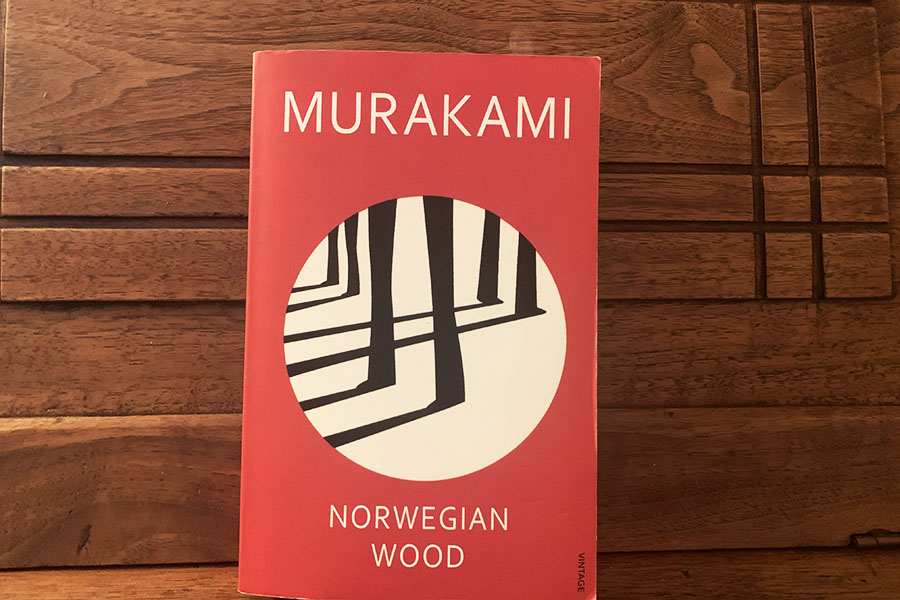Not the Beatles, Murakami
Review Over the Poignant Coming of Age Novel ‘Norwegian Wood’
Japanese writer Haruki Murakami first released the novel that propelled him to international recognition, “Norwegian Wood” in 1987 and has released 28 books in total. The red, white and black cover depicted shows what appears to be shadows cast under slender tree trunks correlating to the title, but the more detailed visual shows pairs of feet with two people facing left and one right.
February 7, 2022
In a train-ride distance from greater-Tokyo to the more remote forests of Kyoto, the novel “Norwegian Wood” by Haruki Murakami presents the ordain youth problems of university education, identity, isolation and love into 307 pages. Sharing its namesake with a Beatles song, the lyrics encapsulate the written idea of distant love and unfair circumstances in the novel.
The story follows protagonist Toru Watanabe who has just begun his studies at a private university in Tokyo. The whole story is a flashback to his life at age 19 during the 1960s from his 30s, which I found interesting as the book does not rotate between the two but is rather just a normal chronological plot structure. Toru experiences the traumatic loss of his childhood best friend, Kizuki, to suicide. He shares a mutual understanding with Kuzuki’s former girlfriend, Naoko, due to the fact that each has never experienced such a strong and deep bond with a person to the same extent as with their deceased friend. I think the character dynamic is relatable to the human experience because often a singular friend can be so valuable, like family, and to lose someone as a developing teen can truly leave a missing void. I relate to this element as I have found strong attachment to individuals friends that I have grown close to rather than a large group.
I would say that Murakami definitely remains true to his signature style of writing in many ways. The protagonist does not exist in an overly extravagant world but rather a straightforward worldview, a mellow tone of speech, and lacks significant backstory. I feel a divide between Toru and the other characters, Midori and Naoko, because his backstory and future motives remain a mystery to the reader. There are always elements of mystery and this is no different for Toru Watanabe. Funnily enough, Toru is a drama major but is not interested in theatre or cannot articulate a rhyme nor reason for deciding this. My introduction to Murakami was “Kafka on the Shore” and I was impressed by the rollercoaster that the novel put me on. Unfortunately the magical realism in “Kafka on the Shore” was not a part of this novel which I think might have been the problem of a slower story progression at times.
The plot continues with the reeling and shouldering of grief. At this point in the novel, I am feeling immersed in the loud and chaotic environment of the new city that appears off-paced to his life. Toru meets an exuberant and charming dormate while at university named Nagasawa. Just like music within the book, there are also books within the book and Nagasawa and Watanabe, as he likes to tease him as, originally connect over literary merit of F. Scott Fitzgerald and Thomas Mann. I enjoyed reading Fitzgerald and I think the interpersonal relations, class and society are similar in this novel. The male gaze described when the two college boys go out with each other I think is more descriptive than necessary, but is in-line with the author’s writing. On the surface, the two characters are similar, but in reality, they act as the novel’s polarity and do not bring out the best attributes in each other. I think there is a powerful lesson in the consequences of complacency and not speaking out that can cause harm to your peers.
The love interest in the book, Naoko, the girlfriend of Toru’s childhood best friend, is primarily living at a psychiatric facility due to her deteriorating mental health and unresolved trauma of Kizuki’s death. Grief returns here in the question of internal healing versus societal standards of speedy recovery. In my opinion, these overarching themes at times are more powerful than the plot. The exchange of letters between Watanabe and Naoko are revealed and they both struggle to reciprocate the love and time needed for each other. I think that the confusion surrounding young love can be understandable for readers. While at school and away from Naoko, a love triangle forms, including another girl, Midori. If Naoko represents the past of Toru Watanabe, I believe that the energized character that is Midori represents the future possibilities that have to be given the opportunity to come to fruition.
While “Norwegian Wood” definitely has its flaws including outdated gender representation and stereotypes, in my opinion, the book is worth a read at least once. Murakami’s opinion of certain people being irredeemable is not one I agree with, but I like viewing this work in a historical context and the themes are classic and timeless that humanity will continue to discuss.



![Jumping off the ground, senior linebacker Bennett Patton snatches the ball out of the air for an interception at Thursday’s game against Chaparral. Patton had two interceptions in the 56-14 victory, tying the school record for interceptions in a game. “I was just playing the game,” Patton said. “[I’m] going to go into next week, forget about it and stay humble.” Photo by Harper Chapman](https://cphswolfpack.com/wp-content/uploads/2025/09/bennett-interception.jpg)
![The fire department came to the school after students were evacuated when smoke started coming from the ceiling of a classroom. All students and staff are safe. “All of my friends left their stuff too, so we couldn’t contact our parents, and it was stressful,” senior Brynn Fowler said. “It was scary because I didn’t know [what was going on], and I couldn’t find anyone because it was a big crowd.” Photo by Anthony Garcia](https://cphswolfpack.com/wp-content/uploads/2025/09/firetruck.jpg)


![Sitting with her friend senior Sohpia Struve at last year’s Austin City Limits Festival, senior Ava Zuniga poses for a picture under a pavilion. They are frequent attendees at ACL, an annual music festival at Zilker Park. “I would recommend seeing a bunch of people,” Zuniga said. “This past year, we camped out for Chappell [Roan] for a really long time. I think the whole point of ACL, [which] is a lot of fun, is that you can go see so many different people, even if you don’t know them. So by camping by one person, it really limits yourself from being able to go see a bunch of people.” Photo courtesy of Ava Zuniga](https://cphswolfpack.com/wp-content/uploads/2025/10/EE9E9484-FE6F-4AA0-B5F5-0C177AB32841-1200x857.jpeg)
![Broadcast, yearbook and newspaper combined for 66 Interscholastic League Press Conference awards this year. Yearbook won 43, newspaper won 14 and broadcast took home nine. “I think [the ILPC awards] are a great way to give the kids some acknowledgement for all of their hard work,” newspaper and yearbook adviser Paige Hert said. “They typically spend the year covering everyone else’s big moments, so it’s really cool for them to be celebrated so many times and in so many different ways.”](https://cphswolfpack.com/wp-content/uploads/2025/05/edited-ILPC.jpg)




![Looking down at his racket, junior Hasun Nguyen hits the green tennis ball. Hasun has played tennis since he was 9 years old, and he is on the varsity team. "I feel like it’s not really appreciated in America as much, but [tennis] is a really competitive and mentally challenging sport,” Nguyen said. “I’m really level-headed and can keep my cool during a match, and that helps me play a bit better under pressure.” Photo by Kyra Cox](https://cphswolfpack.com/wp-content/uploads/2025/09/hasun.jpg)


![Bringing her arm over her head and taking a quick breath, junior Lauren Lucas swims the final laps of the 500 freestyle at the regionals swimming competition on date. Lucas broke the school’s 18-year-old record for the 500 freestyle at regionals and again at state with a time of 4:58.63. “I’d had my eye on that 500 record since my freshman year, so I was really excited to see if I could get it at regionals or districts,” Lucas said. “ State is always a really fun experience and medaling for the first time was really great. It was a very very tight race, [so] I was a bit surprised [that I medaled]. [There were] a lot of fast girls at the meet in general, [and] it was like a dogfight back and forth, back and forth.” Photo by Kaydence Wilkinson](https://cphswolfpack.com/wp-content/uploads/2025/03/Kaydence-2.7-23-edit-2.jpg)
![As the support team sits and poses for a photo in the cafeteria with the counseling team they eagerly wait to start their day. "We [all] seem to be a team, I get up every day and there's days where I don't want to go to work today, but I'm thankful that I have a job and I'm blessed to have what I have," Christopherson said. Photo Courtesy of Julie Weltens.](https://cphswolfpack.com/wp-content/uploads/2025/01/AF9E8470-10D7-4C91-BF28-EC8F86BAB66C-1200x852.jpeg)
![Officer Stephanie Cash is in her second year as an SRO at CPHS. “Seeing [students] grow over the years has been kind of cool,” Officer Cash said. “Freshmen that [are] all over the place and then in the next couple of years get a little more squared away and go to class and do work and start thinking about the future. Being a part of a student's growth is the best way to measure my success as an SRO.” Photo Courtesy of Cedar Park Police Department's PIO, Alicia Gallagher.](https://cphswolfpack.com/wp-content/uploads/2024/12/CPHS-SRO-900x1200.jpg)
![As he sprints with the ball, senior running back Trae Hill breaks a tackle during Friday’s 35-14 loss against the Vandegrift Vipers. Hill ran for 135 yards and two touchdowns during the game. “[Scoring] was electric,” Hill said. “It always feels good to score, but the O-line did everything.”](https://cphswolfpack.com/wp-content/uploads/2025/09/IMG_0795allie.varfb_-1200x799.jpg)


























![The fire department came to the school after students were evacuated when smoke started coming from the ceiling of a classroom. All students and staff are safe. “All of my friends left their stuff too, so we couldn’t contact our parents, and it was stressful,” senior Brynn Fowler said. “It was scary because I didn’t know [what was going on], and I couldn’t find anyone because it was a big crowd.” Photo by Anthony Garcia](https://cphswolfpack.com/wp-content/uploads/2025/09/firetruck-300x200.jpg)

![Finishing her night out after attending a local concert, senior Grace Sauers smiles at the camera. She recently started a business, PrettySick, that takes photos as well as sells merch at local concert venues. Next year, she will attend Columbia Chicago College majoring in Graphic Design. “There's such a good communal scene because there [are] great venues in Austin,” Sauers said. “I'm gonna miss it in Austin, but I do know Chicago is good, it's not like I'm going to the middle of nowhere. I just have to find my footing again.” Photo Courtesy of Grace Sauers.](https://cphswolfpack.com/wp-content/uploads/2025/04/Grace-300x225.png)


